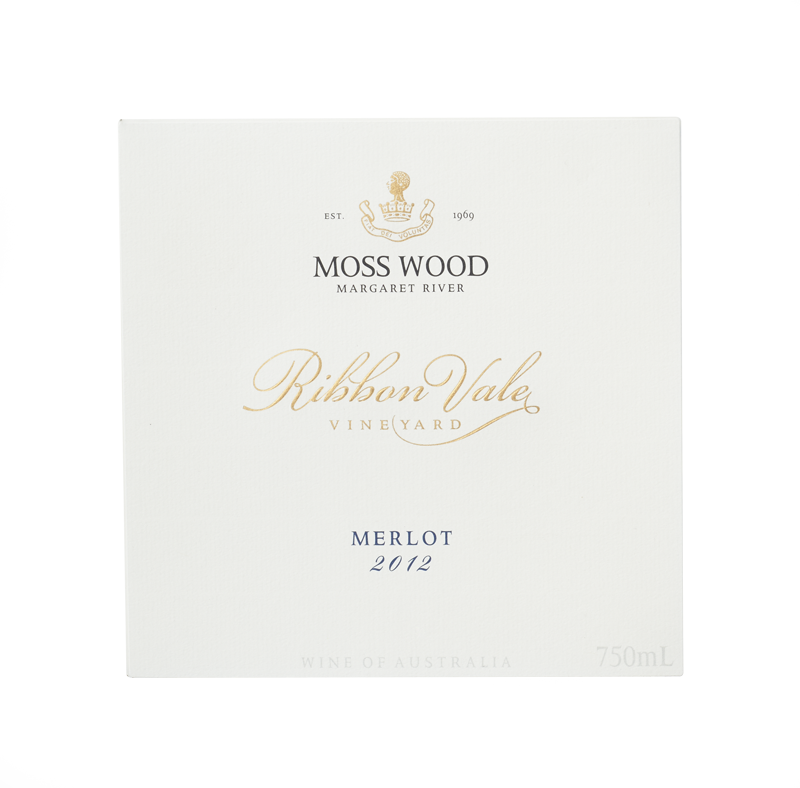Moss Wood Ribbon Vale Vineyard 2012 Merlot
Wine Facts
| Harvested: | 08/03/2012 |
| Bottled: | 12/08/2014 |
| Released: | 20/11/2014 |
| Yield: | t/ha |
| Baume: | 13.513.7 |
| Alcohol: | 14.0% |
| Vintage Rating: | xx/xx |
SOLD OUT
Tasting Notes
Colour and condition: Deep brick red hue; bright condition.
Nose: A really youthful appeal, with an immediate impression of dark fruit aromas – black berries, mulberries and black currants. A second viewing shows the beginnings Merlot’s “darker” side, with tar, leather and earth just starting to add complexity into the background.
Palate: The classic Merlot palate, with rich, dark berry flavours like black jubes filling the front and mid palate. Firm tannin then takes over and gives the wine a linear, astringent but not too aggressive finish, which is juicy and concentrated.
Moss Wood Ribbon Vale 2012 Merlot – Campbell Mattinson, The Wine Front
Medium-bodied merlot out of Margaret River. It’s in pretty decent form. Mulberry, gravel and mint flavours swing amiably through the palate, aided by a light dusting of milk chocolate and pencil-like oak. It turns stern through the finish, as tannin cranks into gear, but at all points it feels well…
Moss Wood Ribbon Vale 2012 Merlot – James Halliday – Wine Companion
Good colour; arguably one of the best merlots in Australia at the present time; a beguiling blend of redcurrant, blackcurrant and plum ripe tannins precisely weighted, French oak integrated and balanced. 96 points / 5 stars
Moss Wood Ribbon Vale 2012 Merlot – Angus Hughson – Wine Genius
Bright mid to deep ruby and showing attractive mulberry, cassis and cedar fruit. Dry, full bodied with plush concentrated fruit it shows good fruit density and structure characterised by a generous finish and impressive tannin integration. 93 points / 18
Moss Wood Ribbon Vale 2012 Merlot – Newcastle Herald – John Lewis
Here’s a quality merlot that shines bright garnet in the glass, has bouquet garni scents and zings onto the front palate with juicy mulberry flavour. The middle palate introduces bramble jelly, liquorice and Turkish delight fruit characters integrated with savoury oak. Dusty tannins come through at the finish. It’s in…
Vintage Notes
The warm conditions meant the length of the flowering to harvest growing season was slightly shorter. Merlot was only one day early, at 115; and Cabernet Franc was 2 days early, at 117.
Naturally, ripeness was good for both varieties. Merlot was slightly riper than average at 13.7⁰; and Cabernet Franc almost average at 13.3⁰.
Yields were also good, albeit slightly below average. Merlot cropped at 7.98 tonnes per hectare, down 7% and Cabernet Franc produced 8.8 tonnes per hectare, down 2%.
Finally, in keeping with the theme of 2012, there were no negative quality influences, with the birds kept under control with the application of the nets and our fungicide spray program was successful in preventing disease. All we had to do was get it safely into the winery and make sure we protected what Mother Nature had given us.
Production Notes
Median Harvest Dates:
Merlot – 8th March, 2012
Cabernet Franc – 8th March, 2012
Harvest Ripeness:
Merlot – 13.7⁰ Baume
Cabernet Franc – 13.5⁰ Baume
All the fruit was hand picked and destemmed into small, open fermenters. Each batch was seeded with a pure yeast culture and was allowed to ferment at up 28⁰C. Colour and flavour were extracted by hand plunging 3 times per day. After approximately 2 weeks on skins each batch was pressed to stainless steel tanks for malolactic fermentation and after completion, racked to oak. All barrels were 225 litre French oak and 10% were new.
In December 2013, the final blends were prepared. The Merlot is blended with 8% Cabernet Franc.
Readers will note this means the wine is not a 100% varietal Merlot. Our reasoning is simple. While Merlot is not given great quality status in Australia things are different overseas. Merlot is the most widely planted red grape in Bordeaux and is dominant in the great wines of St Emilion and Pomerol. These Right Bank wines, as they are often known, are amongst the most highly regarded in the region and are the benchmarks against which we are keen to have our own wine judged.
It is also important to note the great wines from the Right Bank are blends. The percentage of Cabernet Franc and to a lesser extent, Cabernet Sauvignon, used in blending varies between the different chateaux and depends on their individual terroir. However, all agree they make their best wines this way.
Our decisions on the final assemblage are based on careful tasting trials and our experience is similar to the Bordeaux producers. We can make a very good wine from Merlot but we always improve it when we include a small percentage of Cabernet Franc. A large contribution by the latter, say greater than 10%, almost always lower the quality, until the blend approaches 50%, at which point the quality improves. Funnily enough, although it improves, the overall quality is still not high enough to take it back to the top.
After blending the wines were returned to barrel, where they remained until July 2014, when they were racked to stainless steel and prepared for bottling. Fining trials were carried out and the Merlot was fined with a light dose of egg whites.
The wine was sterile filtered and bottled on 12th August 2014.
Cellaring Notes
Merlot has such bright and appealing youthful fruit, it’s always enjoyable to drink as youngster and this wine is no different. However, with its juicy tannins it will hold together well and gradually develop a tarry and leathery bottle bouquet over the next 15 to 20 years.

